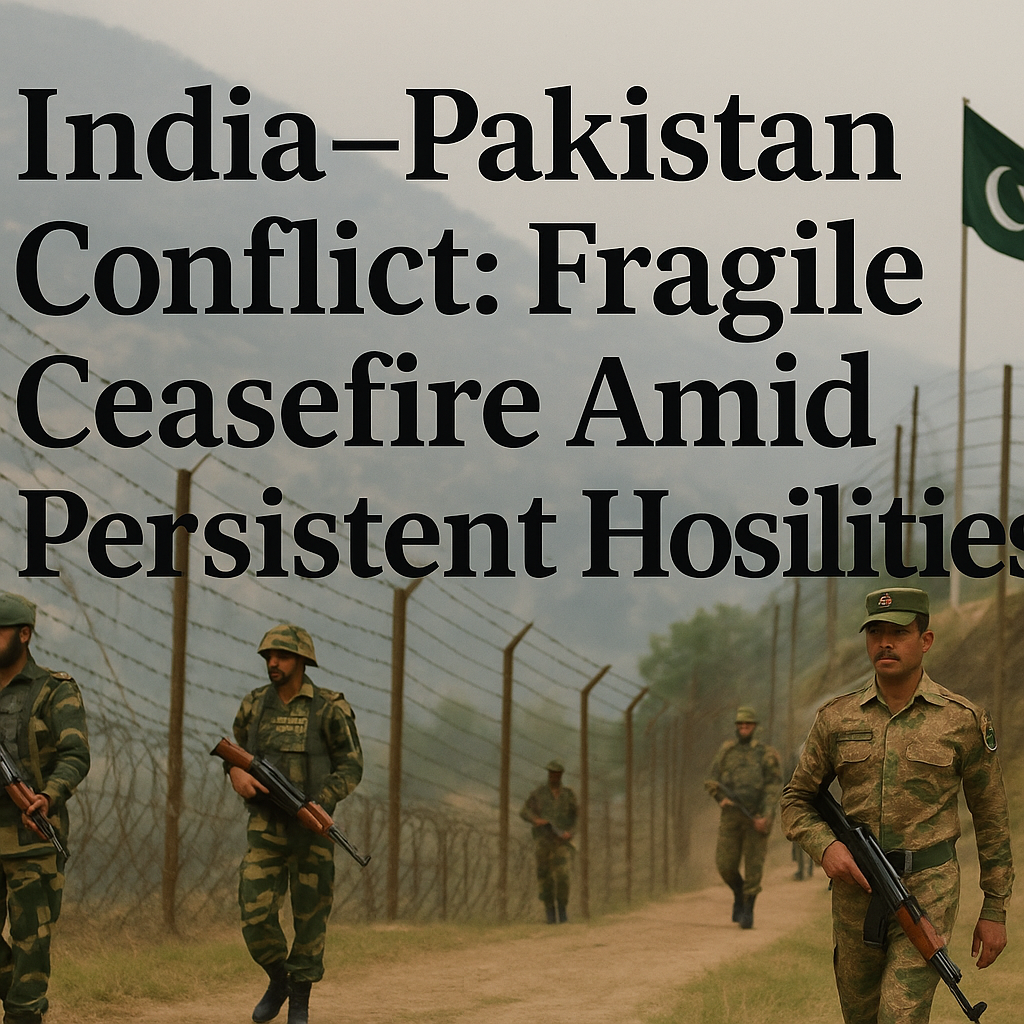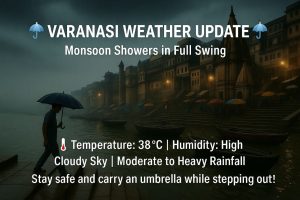India–Pakistan Conflict : Fragile Ceasefire Amid Persistent Hostilities

India–Pakistan Conflict
India–Pakistan Conflict: Fragile Ceasefire Amid Persistent Hostilities
India–Pakistan Conflict: India and Pakistan, two nuclear-armed nations locked in a complex web of history, geopolitics, and ideology, once again found themselves teetering on the edge of open warfare in April 2025. A brutal terror attack in Kashmir triggered a spiral of military strikes and counterstrikes, pushing the subcontinent to the brink of full-scale war. Though a ceasefire agreement was announced in May 2025, the uneasy calm is overshadowed by unresolved tensions, border violations, and distrust. This article delves into the recent developments, diplomatic efforts, and the uncertain path forward in the volatile India–Pakistan relationship.
A New Chapter in a Long History of Conflict
India–Pakistan Conflict: The India–Pakistan conflict is among the world’s longest-running geopolitical rivalries. Rooted in the partition of British India in 1947, the dispute over Jammu and Kashmir has triggered multiple wars (1947, 1965, 1971, and 1999) and dozens of military skirmishes. While both countries have nuclear capabilities, the persistent shadow of terrorism, ceasefire violations, and regional nationalism continue to inflame hostilities.
Despite intermittent peace efforts, including the Lahore Declaration and various ceasefire pacts, none have succeeded in transforming bilateral relations into a lasting peace.
April 2025: The Spark That Ignited a Firestorm
India–Pakistan Conflict: On April 22, 2025, a suicide bombing in Pahalgam, Kashmir, killed dozens of Indian soldiers and civilians. The Indian Ministry of Home Affairs identified the attackers as operatives of Jaish-e-Mohammed (JeM), a Pakistan-based terror outfit. The intelligence community tracked the origin of the attack to a camp near Muzaffarabad, reigniting anger in Indian public discourse.
The incident was widely compared to the Pulwama attack of 2019, with hashtags like #PunishPakistan and #StrikeBack trending on social media. Public opinion overwhelmingly favored military retaliation, and the Indian government acted swiftly.
Operation Sindoor: India’s Strategic Retaliation
India–Pakistan Conflict: On April 24, the Indian Air Force launched Operation Sindoor, a carefully calibrated response targeting JeM infrastructure across the LoC in Pakistan-administered Kashmir. India used satellite-guided missiles, stealth drones, and special forces units to minimize civilian casualties while maximizing operational damage.
Key Outcomes:
- Destroyed 3 known terrorist training centers
- Neutralized over 80 militants, according to Indian intelligence
- Strengthened India’s domestic political position and global narrative on counterterrorism
India emphasized that its actions were “surgical, limited, and defensive,” focusing solely on terror infrastructure rather than civilian or military installations.
Pakistan’s Response: Operation Bunyan al-Marsus
India–Pakistan Conflict: In retaliation, Pakistan launched Operation Bunyan al-Marsus on April 26, targeting Indian border posts in Poonch, Rajouri, and Gurez sectors. Pakistan’s military claimed its actions were a “measured counteroffensive,” but reports from India indicated that civilian zones were also hit.
Pakistan also elevated its nuclear readiness level, moving warheads into high-security mobile transport vehicles, a move that drew sharp criticism from the international community.
The situation worsened when both countries briefly closed their airspace, leading to disruptions in regional aviation and triggering panic among civilians.
Border Communities Caught in the Crossfire
India–Pakistan Conflict: Border communities bore the brunt of the conflict. Thousands fled from Kupwara, Uri, Samba, and Kathua, seeking shelter in government-run camps. Schools were shut, and emergency services were overstretched. In Pakistan-administered Kashmir, similar scenes of fear and evacuation played out, with hospitals overwhelmed by casualties.
International NGOs described the humanitarian impact as “severe,” with water, power, and medical supplies disrupted in conflict zones. The UNHCR called for safe corridors to assist affected populations on both sides.
Global Response: Diplomacy Amid Danger
The international community acted swiftly to defuse the crisis. The United States, United Nations, European Union, and China all urged restraint.
The U.S. Role:
Secretary of State Antony Blinken spoke separately with both PM Narendra Modi and PM Shehbaz Sharif, pushing for immediate de-escalation. The U.S. proposed a neutral zone along the LoC, monitored by international observers.
China’s Cautious Support:
China, a close ally of Pakistan, advocated for calm and suggested joint talks under the Shanghai Cooperation Organisation (SCO) framework, although India rejected third-party mediation.
The Geneva Talks:
After intense backchannel diplomacy, Geneva was chosen as the venue for emergency negotiations. On May 10, 2025, a ceasefire agreement was signed under UN and U.S. mediation, halting all military actions across the LoC.
The Ceasefire Terms: A Blueprint for Temporary Peace
India–Pakistan Conflict: The ceasefire declaration includes:
- A complete halt to cross-border firing
- Re-activation of the Director General Military Operations (DGMO) hotline
- Formation of a Joint Border Commission for monitoring
- Commitment to resume diplomatic talks within 60 days
Despite the formal agreement, both sides have remained cautious in their rhetoric. India reiterated that “terror and talks cannot go together,” while Pakistan insisted on the inclusion of Kashmir in any future dialogue.

Violations and Erosion of Trust
India–Pakistan Conflict: In the days following the ceasefire, sporadic violations have raised concerns. On May 11, Indian forces reported gunfire from across the LoC in the Mendhar sector, resulting in the death of one soldier. Pakistan, in turn, accused India of flying surveillance drones over Kotli and Neelum Valley.
The lack of a third-party enforcement mechanism has made it difficult to verify claims. Experts believe that the ceasefire could collapse unless concrete steps are taken to build confidence.
Political Fallout and Strategic Shifts
In India:
Prime Minister Modi’s decisive military stance has significantly boosted his domestic popularity. With national elections approaching, the government has used the success of Operation Sindoor as a key narrative in campaign speeches.
In Pakistan:
PM Shehbaz Sharif faces internal dissent, with the opposition criticizing his “failure to protect national sovereignty.” The Pakistan Army has become increasingly vocal, hinting at a more assertive foreign policy approach if provoked again.
Economic Consequences
India:
- Stock markets fell by 5% during the escalation.
- Defense spending saw an emergency allocation of ₹20,000 crore.
- Tourism in Jammu and Kashmir dropped by 60%, impacting livelihoods.
Pakistan:
- The rupee weakened against the dollar.
- Fuel prices spiked due to border disruptions.
- International donors paused aid disbursements amid uncertainty.
Both countries have suffered economically, with business leaders calling for long-term stability to ensure investor confidence.
Media and Public Sentiment
India–Pakistan Conflict: The media in both countries played a pivotal role, with nationalist narratives dominating coverage. Indian news channels focused on surgical strikes and martyr tributes, while Pakistani outlets highlighted alleged civilian casualties and sovereignty violations.
Social media further polarized public opinion. Hashtags like #IndiaStrikesBack, #StandWithSoldiers, and #StopIndianAggression trended, reflecting deep-rooted distrust and national pride on both sides.
The Role of Intelligence and Surveillance
India–Pakistan Conflict: The conflict also highlighted the growing importance of cybersecurity and electronic warfare. India’s use of satellite intelligence, drone surveillance, and AI-based targeting systems marked a new era in Indo-Pak military dynamics.
Pakistan responded by deploying jammers and electronic countermeasures, signaling a digital battlefield where misinformation and cyber sabotage could influence outcomes as much as bullets and bombs.
A Fragile Future: Can the Ceasefire Hold?
India–Pakistan Conflict: While the ceasefire is a welcome relief, history shows that such agreements are often short-lived. Real peace requires more than military disengagement—it demands a structural shift in bilateral relations.
Steps Toward Sustainable Peace:
- Reinstitution of Diplomatic Channels: Restore ambassadorial-level communication and regular talks.
- Counter-Terrorism Cooperation: Create a bilateral framework to combat non-state actors.
- Trade Normalization: Reopen trade routes and reduce barriers to cross-border commerce.
- Public Diplomacy: Encourage academic, cultural, and sports exchanges to humanize the conflict.
Conclusion
India–Pakistan Conflict: The India–Pakistan ceasefire of 2025 may have paused the gunfire, but it hasn’t extinguished the fire of distrust. Unless both nations move beyond reactionary politics and towards meaningful engagement, the subcontinent will remain trapped in a loop of violence and diplomacy.
The path to peace is narrow, steep, and filled with obstacles. Yet, for the millions who live under the shadow of the LoC, every day without war is a step worth fighting for.





The India-Pakistan conflict remains a deeply complex issue with no easy solutions. It’s concerning how peace efforts like the Lahore Declaration have failed to bring lasting stability. The emphasis on surgical strikes and terror infrastructure raises questions about the long-term effectiveness of such strategies. The economic toll on both nations is undeniable, and it’s clear that stability is crucial for growth. PM Modi’s popularity surge post-Operation Sindoor seems to overshadow the broader need for dialogue. PM Shehbaz Sharif’s challenges with internal dissent and national sovereignty further complicate the situation. Do you think a neutral mediator could help bridge the gap between these two nations, or is the mistrust too deep to overcome?
The India-Pakistan conflict has been a long-standing issue, and it’s disheartening to see how peace efforts have repeatedly failed to bring lasting solutions. The surgical strikes and the emphasis on terror infrastructure by India seem like a defensive move, but does it really address the root cause of the problem? The closure of airspace and the resulting panic among civilians highlight how deeply this conflict affects ordinary people. It’s interesting how both countries use the situation for domestic political gains, with Modi boosting his popularity and Sharif facing internal dissent. The economic toll on both nations is undeniable, and it’s clear that stability is crucial for progress. The mention of the LoC and the daily struggles of those living there is a stark reminder of the human cost of this conflict. Do you think there’s a realistic path to peace, or are we destined to see this cycle of tension continue indefinitely?
The India-Pakistan conflict seems to be a never-ending cycle of tension and temporary truces. It’s frustrating to see how peace efforts like the Lahore Declaration haven’t led to lasting solutions. The focus on surgical strikes and terror infrastructure feels like a band-aid on a much deeper wound. Both countries’ airspace closures and economic losses highlight how this conflict affects ordinary people more than anyone else. PM Modi’s popularity surge from military actions raises questions about whether peace is truly the priority. And with Pakistan’s internal dissent, it’s hard to see a unified approach to resolving this. Do you think there’s a way to break this cycle, or are we just stuck in this endless loop of hostility?
The India-Pakistan conflict has been a long-standing issue with significant repercussions for both nations. It’s concerning how repeated peace efforts have failed to bring lasting stability, despite agreements like the Lahore Declaration. The focus on surgical strikes and terror infrastructure raises questions about the true intentions behind such actions. PM Modi’s military stance may have boosted his popularity, but does it address the root causes of the conflict? The economic impact on both countries is undeniable, and the call for long-term stability is crucial for regional development. The increasing assertiveness of the Pakistan Army suggests that tensions could escalate further if provoked. How can both nations move beyond rhetoric and take concrete steps towards peace that benefits their citizens?
What concrete measures do you think could be implemented to ensure sustainable peace and economic stability in the region?